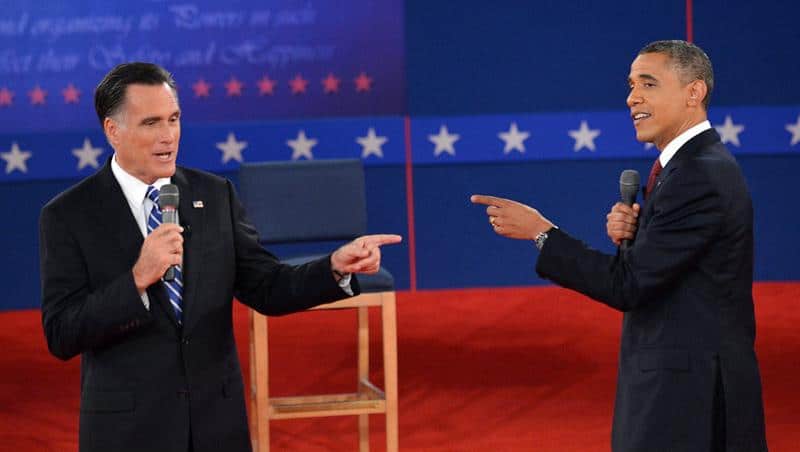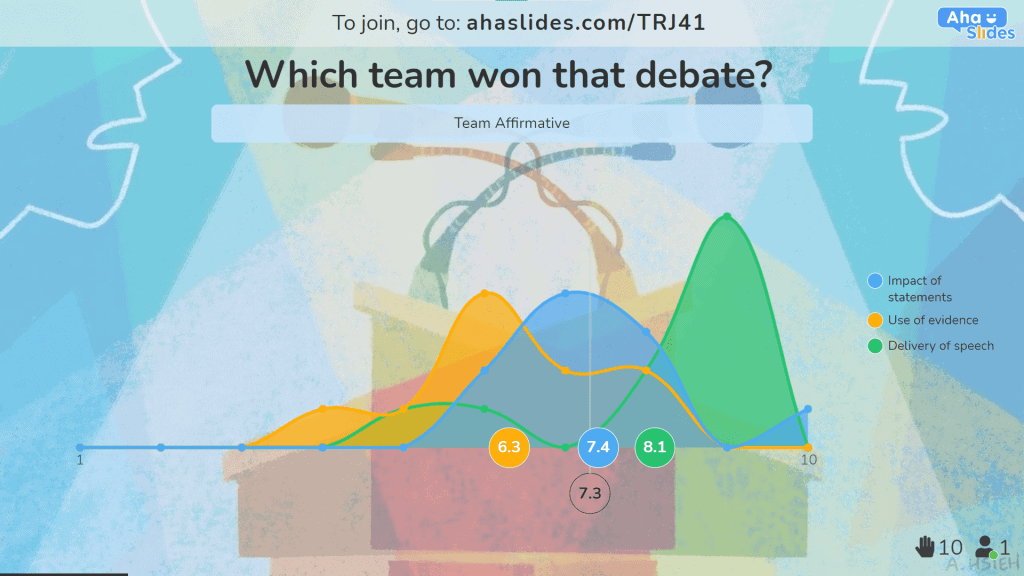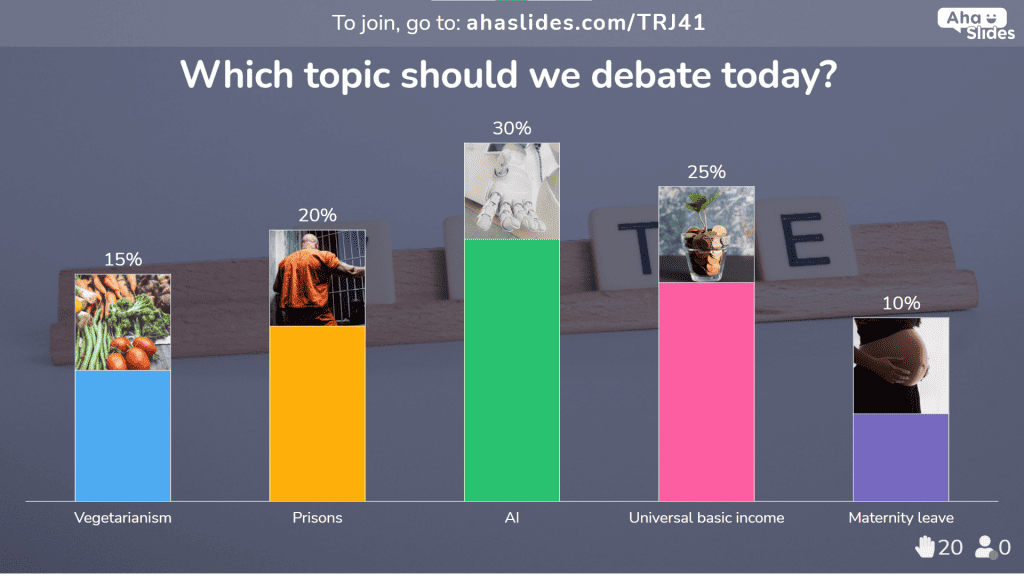There's no debate here; student debates are one of the best ways to encourage critical thinking, engage students and put learning in the hands of the learners.
They're not just for argumentative classes or budding politicians, and they're not just for smaller or more mature courses. Student debates are for everyone, and they're rightfully becoming a mainstay of school curricula.
Here, we dive into the world of classroom debating. We look at the benefits and various types of student debates, as well as topics, a great example and, crucially, how to set up your own fruitful, meaningful class debate in 6 simple steps.
Why Student Debates Need More Love

Regular debating in class can profoundly shape both personal and professional aspects of a student's life. Here are a few of the ways in which having meaningful class discussions can be a seriously worthwhile investment in students' nows and their futures:
- The Power of Persuasion - Student debates teach learners that there's always a contemplative, data-driven approach towards any impasse. Students learn how to form a convincing, measured argument that, for some, may be helpful on a daily occurrence in the future.
- The Virtue of Tolerance - On the flip side, holding a student debate in class also builds listening skills. It teaches learners to truly listen to opinions that differ from their own and understand the sources of those differences. Even losing in a debate lets students know that it's okay to change their minds on a matter.
- 100% Possible Online - At a time when teachers are still struggling to migrate the in-class experience online, student debates offer a hassle-free activity that requires no physical space. There are alterations to make, sure, but there's no reason why student debates shouldn't be part of your approach to online teaching.
- Student-Centric - The benefits of putting students, not subjects, at the centre of learning are already well explored. A student debate gives learners more-or-less free reign over what they say, what they do and how they respond.
6 Steps for Holding a Student Debate
Step #1 - Introduce the Topic
For the debate structure, firstly, naturally, the first step to holding a school debate is giving them something to talk about. The scope of topics for a class debate is virtually unlimited, even impromptu debate topics. You can provide any statement, or ask any yes/no question, and let the two sides go at it as long as you ensure debate rules.
Still, the best topic is the one that splits your class as close to down the middle as possible. If you need some inspiration, we've got 40 student debate topics down here.
A great way to choose the perfect topic is by gathering preliminary opinions on it within your class, and seeing which one has a more-or-less even number of students on each side:

Though a simple yes/no poll like the one above may do, there are many other creative ways to determine and set up the topic for your students to discuss:
- Image poll - Present some images and see which one each student identifies with the most.
- Word Cloud - See how often the class uses the same word when they're expressing opinions.
- Rating scale - Present statements on a sliding scale and get students to rate agreement from 1 to 5.
- Open-ended questions - Let students have the freedom to express their opinions on a topic.
Free Download! ⭐ You can find all of these questions in the free AhaSlides template below. Your students can answer these questions live via their phones, and then see visualised data about the whole class' opinions.
Step #2 - Create the Teams and Determine the Roles
With the topic in the bag, the next step is to form the 2 sides discussing it. In debating, these sides are known as the affirmative and the negative.
- Team Affirmative - The side agreeing with the proposed statement (or voting 'yes' to the proposed question), which is usually a change to the status quo.
- Team Negative - The side disagrees with the proposed statement (or voting 'no' to the proposed question) and wants to keep things the way they're done.
Actually, 2 sides are the bare minimum you need. If you have a large class or a sizeable number of students who aren't entirely in favour of the affirmative or the negative, you can expand the learning potential by expanding the number of teams.
- Team Middle Ground - The side wants to change the status quo but still keeps some things the same. They can refute points from either side and try to find a compromise between both.
Tip #1 💡 Don't punish fence-sitters. While one of the reasons to have a student debate is to make learners more confident in voicing their opinions, there will be times when they're genuinely in the middle ground. Let them occupy this stance, but they should know it's not a ticket out of the debate.
The rest of your class will comprise the judges. They will listen to each point in the debate and will score each team's overall performance depending on the scoring system you set out later.
As for each speaker's team roles, you can set these how you like. One popular format amongst student debates in class is the one used in the British parliament:

This involves 4 speakers on each team, but you can expand this for larger classes by assigning two students to each role and giving them one point each to make during their allotted time.
Step #3 - Explain How it Works
There are 3 crucial parts of a student debate that you have to make crystal clear before you begin. These are your barricades against the kind of anarchical debate you may experience in the actual British parliament. And significant parts of a debate are the structure, the rules and the scoring system.
--- The Structure ---
A student debate, first and foremost, needs to have a solid structure and obey debate guidelines. It needs to be lateral so that no one can talk over each other, and it needs to allow adequate time for learners to make their points.
Check out the structure of this example student debate. The debate always starts with Team Affirmative and is followed by Team Negative
| Team Affirmative | Team Negative | Time Allowance for Each Team |
| Opening statement by 1st speaker. They will state their main points of support to the proposed change | Opening statement by 1st speaker. They will state their main points of support for the proposed change | 5 minutes |
| Prepare rebuttals. | Prepare rebuttals. | 3 minutes |
| Rebuttal by 2nd speaker. They will argue against the points presented in Team Negative's opening statement. | Rebuttal by 2nd speaker. They will argue against the points presented in Team Affirmative's opening statement. | 3 minutes |
| Second rebuttal by 3rd speaker. They will rebut Team Negative's rebuttal. | Second rebuttal by 3rd speaker. They will rebut Team Affirmative's rebuttal. | 3 minutes |
| Prepare rebuttal and closing statement. | Prepare rebuttal and closing statement. | 5 minutes |
| Final rebuttal and closing statement by 4th speaker. | Final rebuttal and closing statement by 4th speaker. | 5 minutes |
Tip #2 💡 The structures of a student debate can be flexible while experimenting with what works but should be set in stone when the final structure has been decided. Keep an eye on the clock, and don't let speakers overstep their time slot.
--- The Rules ---
The strictness of your rules depends on the likelihood that your class will dissolve into politicians upon hearing the opening statements. Yet, no matter who you teach, there will always be overly vocal students and students who don't want to speak up. Clear rules help you level the playing field and encourage participation from everyone.
Here are some you'll probably want to use in your class discussion:
- Stick to the structure! Do not talk when it's not your turn.
- Stay on topic.
- No swearing.
- No resorting to personal attacks.
--- The Scoring System ---
Though the point of a classroom debate is not really to 'win', you'll probably find that the natural competitiveness of your students demands some points-based placation.
You can award points for...
- Impactful statements
- Data-backed evidence
- Eloquent delivery
- Strong body language
- Use of relevant visuals
- True understanding of the topic
Of course, judging a debate is never a game of pure numbers. You, or your team of judges, must bring out your best analytical skills to score each side of the debate.
Tip #3 💡 For debate in an ESL classroom, where the language used is much more important than points made, you should reward criteria such as different grammar structures and advanced vocabulary. At the same time, you can also deduct points for using native language.
Step #4 - Time to Research and Write

Is everyone clear on the topic and classroom discussion rules? Good! It's time to prepare your arguments.
On your part, what you have to do here is set the time limit for the research, lay out some predetermined sources of info, and then monitor your students to be sure that they're staying on-topic.
They should research their points and brainstorm possible rebuttals from the other team and decide what they would say in response. Likewise, they should anticipate their opponents' points and consider rebuttals.
Step #5 - Prepare the Room (or the Zoom)
While your teams are finalising their points, it's time to prepare for the show.
Do your best to recreate the atmosphere of a professional debate by arranging tables and chairs to face each other across the room. Usually, the speaker will stand on a podium in front of their table and will return to their table when they're finished talking.
Naturally, things are a little tougher if you're hosting a student debate online. Still, there are a few fun ways to differentiate the teams on Zoom:
- Get each team to come up with team colours and decorate their Zoom backgrounds with them or wear them as a uniform.
- Encourage each team to invent a team mascot and for each member to show it on screen while debating.
Step #6 - Debate!
Let battle commence!
Remember that this is your student's time to shine; try to butt in as little as possible. If you have to speak, make sure it's just to keep order amongst the class or to relay the structure or scoring system. Plus, here are some introduction examples for you to rock your debate!
Cap the debate by scoring each team on the criteria you laid out in the scoring system. Your judges can fill out the scores of each criterion throughout the debate, after which the scores can be tallied, and the average number across each bar will be the team's final score.
Tip #4 💡 It may be tempting to jump straight into a deep debate analysis, but this is best saved until the next lesson. Let students relax, think over the points and come back next time to analyse them.
Different Types of Student Debate to Try
The structure above is sometimes referred to as the Lincoln-Douglas format, made famous by a series of fiery debates between Abraham Lincoln and Stephen Douglas. However, there's more than one way to tango when it comes to debating in class:
- Roleplay Debate - Students act out a debate based on the opinions of a fictional or non-fictional character. This is a great way to get them to open their minds and try putting forward a convincing argument with views different to their own.
- Impromptu Debate - Think pop quiz, but for debating! Impromptu student debates give speakers no time to prepare, which is a good exercise in improvisational and critical thinking skills.
- Town Hall Debate - Two or more students face the audience and answer questions from them. Each side gets a chance to answer each question and can refute each other as long as it stays more-or-less civilised!
Check out the best 13 online debate games for students of all ages (+30 topics)!

Need more ways to engage your students? 💡 Check out these 12 student engagement ideas or, the flipped classroom technique, for in-person and online classrooms!
40 Classroom Debate Topics
Are you looking for some inspiration to bring your debate to the classroom floor? Take a look through these 40 student debate topics below and take a vote with your students on which to go with.
School Topics for a Student Debate
- Should we create a hybrid classroom and have both remote and in-class learning?
- Should we ban uniforms in school?
- Should we ban homework?
- Should we try the flipped classroom model of learning?
- Should we do more learning outside?
- Should we abolish exams and tests through coursework?
- Should everyone go to university?
- Should university fees be lower?
- Should we have a class on investment?
- Should esports be part of gym class?
Environment Topics for Student Debate
- Should we ban zoos?
- Should it be allowed to keep exotic cats as pets?
- Should we build more nuclear power plants?
- Should we try to slow the birth rate worldwide?
- Should we ban all single-use plastic?
- Should we turn private lawns into allotments and wildlife habitats?
- Should we start an 'international government for the environment'?
- Should we force people to change their ways to combat climate change?
- Should we discourage 'fast fashion'?
- Should we ban domestic flights in small countries with good train and bus systems?
Society Topics for Student Debate
- Should we all be vegetarian or vegan?
- Should we limit video game playing time?
- Should we limit the time spent on social media?
- Should we make all bathrooms gender-neutral?
- Should we lengthen the standard period of maternity leave?
- Should we keep inventing AI that can do all jobs?
- Should we have a universal basic income?
- Should prisons be for punishment or rehab?
- Should we adopt a social credit system?
- Should we ban adverts that use our data?
Hypothetical Topics for Student Debate
- If immortality was an option, would you take it?
- If stealing was made legal, would you do it?
- If we could clone animals easily and cheaply, should we do it?
- If one vaccine could prevent all spreadable diseases, should we force people to take it?
- If we could easily move to another planet like Earth, should we?
- If no animals were at risk of extinction, should farming of all animals be legal?
- If you could choose to never work and still live comfortably, would you?
- If you could choose to live comfortably anywhere in the world, would you move tomorrow?
- If you could choose to buy a puppy or adopt an older dog, which would you go for?
- If eating out was the same price as cooking for yourself, would you eat out every day?
You may want to give a selection of these debate topics to your students, who will have the final say on which one to take to the floor. You can use a simple poll for this, or ask more nuanced questions about the characteristics of each topic to see which one the students are most comfortable discussing.
Poll your students for free! ⭐ AhaSlides helps you put students at the centre of the classroom and give them a voice through live polling, AI-powered quizzing and idea exchanging. In terms of raising student engagement, there's no debate.
The Perfect Student Debate Example
We'll leave you with one of the absolute best examples of student debates from a show on the Korean broadcasting network Arirang. The show, Intelligence - High School Debate, has pretty much every facet of a beautiful student debate that teachers should aspire to bring to their classrooms.
Check it out:
Tip #5 💡 Manage your expectations. The kids in this program are absolute pros, and many debate eloquently with English as their second language. Don't expect your students to be at the same level - essential participation is a good start!
Frequently Asked Questions
How many types of student debates are there?
There are several types of student debates, each with its own format and rules. Some of the common ones are policy debate, Lincoln-Douglas debate, public forum debate, impromptu debate and roundtable debate.
Why should students debate?
Debates encourage students to analyse issues from multiple perspectives, evaluate evidence, and form logical arguments.
How can I help students research their assigned positions?
Provide them with reliable sources like credible websites, academic journals, and news articles. Guide them on proper citation methods and fact-checking strategies.











